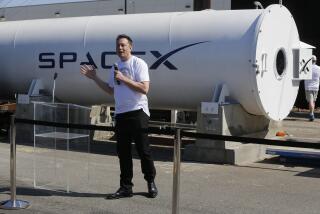Thinking Big Is No Small Task for Research Group
- Share via
TOKYO — Masaki Nakajima thinks big--like building a superhighway from central Europe to China or turning the Sahara green.
Better to spend huge sums of money on things like that, he says, than pouring it into guns and bombs.
“What we need now is a concrete and widely acceptable alternative to the escalating arms race and arms sales that keeps alive the threat of nuclear destruction,” Nakajima told a recent luncheon here in his honor.
He is the director of the Mitsubishi Research Institute, a think tank. He also is a moving force behind the Global Infrastructure Fund, which promotes his ideas.
Megaprojects Pushed
The fund’s purpose is to get world leaders and large corporations to fund 15 or so megaprojects like the Europe-China highway--a modern version of the ancient Silk Road--with the aim of eradicating world hunger, creating new energy sources and linking nations through prodigious transportation and communication networks.
Other megaprojects include a bridge tunnel across the Strait of Gibraltar, a highway running north and south in Europe and a global network of super seaports.
Another proposal is a tunnel between Japan and Korea, under the Sea of Japan. Still another is for a dam on the Sanpo River between China and the Indian province of Assam. The dam would divert the river through a tunnel under the Himalayas to India, making possible a hydroelectric project that could generate 330 billion kilowatt-hours of power a year.
Big Price Tag
Nakajima, a former Finance Ministry official and international banker, is the first to say megaprojects don’t come cheap. The fund puts the cost of financing the proposed megaprojects at $500 billion, a figure Nakajima says roughly corresponds to total U.S. military expenditures during World War II.
Nakajima says the bulk of Global Infrastructure’s funding could come from a gradual cutback in the money nations spend on arms, thereby allowing the world economic system to follow a more peaceful and steady course.
A 2% to 3% reduction in worldwide arms spending, he argues, would more than cover the proposed budget.
Noriyo Yamamoto, a research director at the Mitsubishi Research Institute and Global Infrastructure’s chairman emeritus, says Japan should take the initiative in contributing capital for the projects. Nakajima maintains that if Japan did so it would shed its image as an “economic animal,” because some of its wealth would be helping others.
Concepts Endorsed
The first Global Infrastructure Projects Conference, a gathering of about 60 scientists, businessmen and intellectuals from four continents, was held in Anchorage, Alaska, last July, and Yamamoto said it catapulted the fund into the global arena.
All participants signed a declaration endorsing Nakajima’s concepts, and some came up with a few ideas of their own.
Harold Heinze, for example, proposed building World Route 1--a road from Alaska’s Prudhoe Bay to Norway via the North Pole that would shorten trade routes between North America and northern Europe. Heinze is president of Arco Alaska Inc., an oil company.
Masao Kunihiro, a university professor, said Nakajima remained a “voice in the wilderness” in Japan from the time he first proposed the fund in 1977 until his ideas started to draw attention in Europe and the United States.
Japan’s Awareness Grows
“This has happened time and again in Japan--a Japanese person advocating something falling on deaf ears,” Kunihiro said. “But when a proposal like Nakajima’s is heeded to outside Japan, then the Japanese people all of a sudden discover or rediscover it.”
He noted that film maker Akira Kurosawa was virtually ignored in Japan until the movie “Rashoman” won Hollywood’s Academy Award for best foreign film in 1951.
More to Read
Sign up for Essential California
The most important California stories and recommendations in your inbox every morning.
You may occasionally receive promotional content from the Los Angeles Times.










